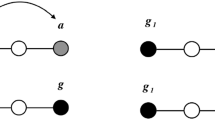Abstract
In the eternal domination game played on graphs, an attacker attacks a vertex at each turn and a team of guards must move a guard to the attacked vertex to defend it. The guards may only move to adjacent vertices on their turn. The goal is to determine the eternal domination number \(\gamma ^{\infty }_{all}\) of a graph, which is the minimum number of guards required to defend against an infinite sequence of attacks. This paper first continues the study of the eternal domination game on strong grids \(P_n\boxtimes P_m\). Cartesian grids \(P_n \square P_m\) have been vastly studied with tight bounds existing for small grids such as \(k\times n\) grids for \(k\in \{2,3,4,5\}\). It was recently proven that \(\gamma ^{\infty }_{all}(P_n \square P_m)=\gamma (P_n \square P_m)+O(n+m)\) where \(\gamma (P_n \square P_m)\) is the domination number of \(P_n \square P_m\) which lower bounds the eternal domination number [Lamprou et al. Eternally dominating large grids. Theoretical Computer Science, 794:27–46, 2019]. We prove that, for all \(n,m\in \mathbb {N^*}\) such that \(m\ge n\), \(\lfloor \frac{n}{3} \rfloor \lfloor \frac{m}{3} \rfloor +\Omega (n+m)=\gamma _{all}^{\infty } (P_{n}\boxtimes P_{m})=\lceil \frac{n}{3} \rceil \lceil \frac{m}{3} \rceil + O(m\sqrt{n})\) (note that \(\lceil \frac{n}{3} \rceil \lceil \frac{m}{3} \rceil\) is the domination number of \(P_n\boxtimes P_m\)). We then generalise our technique to prove that \(\gamma _{all}^{\infty }(G)=\gamma (G)+o(\gamma (G))\) for all graphs \(G\in {\mathcal {F}}\), where \({\mathcal {F}}\) is a large family of D-dimensional grids which are supergraphs of the D-dimensional Cartesian grid and subgraphs of the D-dimensional strong grid. In particular, \({\mathcal {F}}\) includes both the D-dimensional Cartesian grid and the D-dimensional strong grid.















Similar content being viewed by others
Notes
\(D \subseteq V\) is a dominating set of G if every vertex is in D or adjacent to a vertex in D.
\(\alpha (G)\) is the maximum size of an independent set in G.
\(\theta (G)\) is the minimum number of complete subgraphs of G whose union covers V(G).
References
Arquilla, J., Fredricksen, H.: ”Graphing” an optimal grand strategy. Mil. Oper. Res. 1(3), 3–17 (1995)
Bagan, G., Joffard, A., Kheddouci, H.: Eternal dominating sets on digraphs and orientations of graphs. CoRR (2018). arXiv:1805.09623
Bard, S., Duffy, C., Edwards, M., Macgillivray, G., Yang, F.: Eternal domination in split graphs. J. Comb. Math. Comb. Comput. 101, 121–130 (2017)
Beaton, I., Finbow, S., MacDonald, J.A.: Eternal domination numbers of \(4\times n\) grid graphs. J. Comb. Math. Comb. Comput. 85, 33–48 (2013)
Braga, A., de Souza, C.C., Lee, O.: The eternal dominating set problem for proper interval graphs. Inf. Process. Lett. 115(6–8), 582–587 (2015)
Burger, A., Cockayne, E.J., Gründlingh, W.R., Mynhardt, C.M., van Vuuren, J.H., Winterbach, W.: Infinite order domination in graphs. J. Comb. Math. Comb. Comput. 50, 179–194 (2004)
Cohen, N., Mc Inerney, F., Nisse, N., Pérennes, S.: Study of a combinatorial game in graphs through linear programming. Algorithmica 82(2), 212–244 (2020)
Cohen, N., Martins, N .A., Mc Inerney, F., Nisse, N., Pérennes, S., Sampaio, R.: Spy-game on graphs: complexity and simple topologies. Theor. Comput. Sci. 725, 1–15 (2018)
Diestel, R.: Graph Theory. Graduate Texts in Mathematics, 5th edn. Springer, Berlin (2012)
Finbow, S., Messinger, M.E., van Bommel, M.F.: Eternal domination in \(3 \times n\) grids. Australas. J. Comb. 61, 156–174 (2015)
Gagnon, A., Hassler, A., Huang, J., Krim-Yee, A., Mc Inerney, F., Mejía Zacarías, A., Seamone, B., Virgile, V.: A method for eternally dominating strong grids. Discrete Math. Theor. Comput. Sci. (2020). arXiv:2003.01495
Goddard, W., Hedetniemi, S.M., Hedetniemi, S.T.: Eternal security in graphs. J. Comb. Math. Comb. Comput. 52, 160–180 (2005)
Goldwasser, J.L., Klostermeyer, W.F., Mynhardt, C.M.: Eternal protection in grid graphs. Util. Math. 91, 47–64 (2013)
Gonçalves, D., Pinlou, A., Rao, M., Thomassé, S.: The domination number of grids. SIAM J. Discrete Math. 25(3), 1443–1453 (2011)
Klostermeyer, W., Lawrence, M., MacGillivray, G.: Dynamic dominating sets: the eviction model for eternal domination. J. Combin. Math. Combin. Comput 97, 247–269 (2016)
Klostermeyer, W.F., MacGillivray, G.: Eternal dominating sets in graphs. J. Comb. Math. Comb. Comput. 68, 97–111 (2009)
Klostermeyer, W.F., Mynhardt, C.M.: Eternal total domination in graphs. Ars Comb. 68, 473–492 (2012)
Klostermeyer, W.F., Mynhardt, C.M.: Protecting a graph with mobile guards. Appl. Anal. Discrete Mathem. 10(1), 1–29 (2016)
Lamprou, I., Martin, R., Schewe, S.: Eternally dominating large grids. Theorer. Comput. Sci. 794, 27–46 (2019)
Mc Inerney, F., Nisse, N., Pérennes, S.: Eternal domination in grids. In :Proceedings of the 11th international conference on algorithms and complexity, CIAC 2019, volume 11485 of lecture notes in computer science. Springer, Cham, pp 311–322 (2019)
Messinger, M.E.: Closing the gap: eternal domination on \(3\times n\) grids. Contrib. Discrete Mathem. 12(1), 47–61 (2017)
Revelle, C.S.: Can you protect the roman empire? Johns Hopkins Magazine 50(2) (1997)
Revelle, C.S., Rosing, K.E.: Defendens imperium romanum: a classical problem in military strategy. Am. Mathem. Monthly 107, 585–594 (2000)
Rinemberg, M., Soulignac, F.J.: The eternal dominating set problem for interval graphs. Inf. Process. Lett. 146, 27–29 (2019)
Stewart, I.: Defend the Roman empire!. Sci. Am. 281(6), 136–138 (1999)
van Bommel, C.M., van Bommel, M.F.: Eternal domination numbers of \(5\times n\) grid graphs. J. Comb. Math. Comb. Comput. 97, 83–102 (2016)
Author information
Authors and Affiliations
Corresponding author
Additional information
Publisher's Note
Springer Nature remains neutral with regard to jurisdictional claims in published maps and institutional affiliations.
This work has been partially supported by the ANR project DISTANCIA (ANR-14-CE25-0006). An extended abstract of part of this paper has been presented in [20].
Rights and permissions
About this article
Cite this article
Mc Inerney, F., Nisse, N. & Pérennes, S. Eternal Domination: D-Dimensional Cartesian and Strong Grids and Everything in Between. Algorithmica 83, 1459–1492 (2021). https://doi.org/10.1007/s00453-020-00790-8
Received:
Accepted:
Published:
Issue Date:
DOI: https://doi.org/10.1007/s00453-020-00790-8




